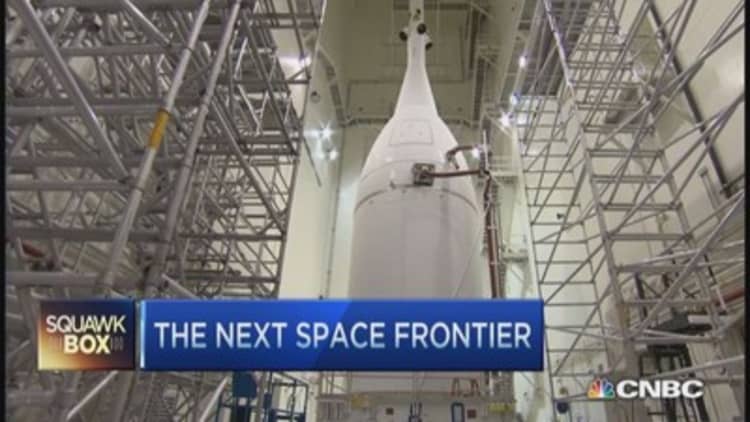
Inside a secure facility at Kennedy Space Center is NASA's 72-foot-tall plan for getting humans to Mars. The Orion, built by Lockheed Martin, is preparing to roll out onto a launchpad next week, attach itself to a massive Delta IV rocket, and go through the final stages before a planned, unmanned test launch on Dec. 4.
"This test is to really take the riskiest parts of that mission and exercise them in a test flight," said NASA's Orion program manager Mark Geyer.
Those risky parts include testing the new launch abort system that would pull Orion free from a rocket explosion. The mission will also test how new computers handle higher levels of radiation, and it will test the parachutes on splashdown—Orion must slow from 20,000 miles per hour (nearly as fast as a lunar return) to 20 miles per hour. To reach that re-entry speed, Orion will go 15 times higher than the International Space Station, the highest orbit in 40 years.
Most of all, NASA and Lockheed will test the performance of Orion's heat shield, the largest ever made, and manufactured with new materials. It will have to sustain temperatures of 4,000 degrees.
Read MoreNASA creates space sounds playlist
"I think that's the key part, and the hardest part to test on the ground," said Geyer.
The Navy will provide the only human element in the December test, as divers will retrieve Orion after splashdown off the coast of Baja, California. Carefully.
"A very good thing about Orion is it can float," said Jeremy Graeber, the recovery director, adding that divers will take their time approaching the craft.
One of the engines being tested in the launch abort system is from Aerojet Rocketdyne, the company that provided an engine that may have failed in an Orbital Sciences launch last week, according to Orbital.
"We don't have any common elements with those launches," NASA's Geyer said.
The test flight will cost $370 million, which accounts for the cost of the rocket and the material that will be discarded. Michael Hawes, who runs the Orion program for Lockheed Martin, said the government has spent more than $5 billion on Orion so far, about half the expected total.
"Financially it's a big program for the company," he said. "It is the major program in our space business."
CNBC was given an exclusive look at the Orion as it was being prepped. Engineers were raising the temperature inside the hangar to over 80 degrees so that when the spacecraft leaves Monday night to travel in the warm Florida air to the launchpad, a sudden change in temperature won't cause condensation.
Read MoreOrbital Sciences: The quiet company in Musk's shadow
The process is unfolding after a difficult week for the space business, with the and the death of a test pilot for Virgin Galactic. At the same time, the film "Interstellar" hits theaters this weekend, reminding people that we may not be able to stay on Earth forever.
"It's a tough business we're in," said William Hill of NASA's Exploration Systems Development program.
"In a sense, it sets everybody back a bit," Hawes said of last week's disasters. "Part of it is that each team, when you have a setback, you have to go back and determine (the) root case of that accident. You have to figure what components were really involved. Those could translate to other systems. But it also, I think, sets back the public perception of 'Can we fly safely?'"
While the disasters have happened on the private space side, the Orion program is largely run by NASA. In a hybrid of old and new business models, Lockheed Martin is actually in charge of this first mission, though NASA personnel are part of what Hawes calls a "blended team."
It reminds us that we need to be vigilant, that safety is key, and we need to remember the details.Mark GeyerNASA Orion program manager, on recent private-industry failures
Geyer won't say how much contracting out this first test flight to Lockheed Martin is saving taxpayers, though he did say it makes financial sense. He said Lockheed has expertise in areas that NASA "doesn't need to get in the middle of."
"They know how to integrate rockets. They've built rockets," he said. "So we contracted with them and we said, 'Look, I'm going to give you these objectives. I want you to test the heat shield, I want you to test the avionics. I want you to test the parachutes.'"
Lockheed and the United Launch Alliance, which is providing the rocket, even took an unusual step for a NASA space flight and licensed both the launch and re-entry with the Federal Aviation Administration. After this flight, however, NASA will take the lead.
Much of Orion borrows from the Apollo and space shuttle systems, but not everything.
Read MorePilot actions in Virgin Galactic crash
"The shape is very similar to Apollo, because the physics haven't changed," Geyer said.
However, Hawes said, "Everything inside is new."
Changes include using composite materials that lighten the craft and a new cockpit reducing the 300 switches from Apollo to about 50 for Orion. Some components were created using 3-D printing.
If all goes well, another test flight will be going into a very high orbit around the moon, which will include a service module built by Airbus, and by 2021, a manned mission. NASA is less interested in returning to the moon and more interested in reaching an asteroid, towing it into lunar orbit, and using it as a potential base from which to go to Mars.
Currently the Orion program is budgeted for about $1 billion a year. Geyer hopes that continues, but he and everyone may be feeling more pressure than ever to see next month's test succeed, given failures elsewhere.
"It reminds us that we need to be vigilant, that safety is key, and we need to remember the details," he said.


